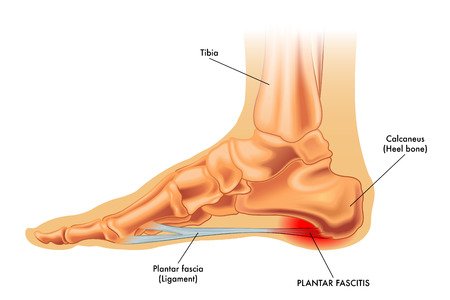HEEL PAIN | PLANTAR FASCIITIS | HEEL SPURS
Heel pain is most often caused by plantar fasciitis, a condition that is sometimes also called heel spur syndrome when a spur is present. Heel pain may also be due to other causes, such as a stress fracture, tendonitis, arthritis, nerve irritation or, rarely, a cyst.
Because there are several potential causes, it is important to have heel pain properly diagnosed. At The Foot and Ankle Center of Maryland, we can distinguish between all the possibilities and determine the underlying source of your heel pain.
What Is Plantar Fasciitis?
Plantar fasciitis is one of the most common causes of heel pain. The plantar fascia is a band of tissue that runs along the bottom of the foot from the heel bone to the toes. This tissue helps to form the foot’s arch. With overuse such as running or standing for long periods on hard surfaces, or from wearing shoes with little support, tiny tears can develop in the plantar fascia. These can cause inflammation and heel pain.
Symptoms
Many of the symptoms include pain when you first get up in the morning, burning, numbness and increased symptoms by the end of the day. The pain is usually caused by tightening of the plantar fascia ligament located on the bottom of the foot. The plantar fascia ligament supports the arch. When you're resting, the ligament contracts. As you start to walk, the ligament pulls and may tear slightly causing pain. Heel pain can also be brought on by trauma.
Treatment
Once plantar fasciitis has been identified as the cause of your heel pain, we use conservative and non-invasive treatments including resting and icing the area, along with anti-inflammatory drugs to reduce inflammation. A steroid injection can also relieve inflammation and pain.
Wearing a brace to keep the plantar fascia stretched at night can be very effective.
Physical therapy will help. Strengthening and stretching exercises and massage will restore the plantar fascia’s flexibility.
Proper foot support is one of the most important treatments we recommend. The purpose of foot support is to stop the ligament from tearing, thereby, getting at the cause of the problem. We often prescribe custom orthotics for the best possible foot support. Custom orthotics are inserts that fit into your shoes, which are custom molded specifically to your foot, to correct the faulty foot alignment and bring your foot into a more correct position. We find that most of our patients respond to conservative treatment with favorable outcomes.
There are more intense treatments available for persistent pain, and surgery may be recommended in severe cases.
Prevention
Some lifestyle changes can help a return of plantar fasciitis:
Lose excess pounds if you are overweight.
Choose sturdy shoes with good support.
Avoid wearing high heels.
Low-impact exercises such as biking and swimming are better for your heels than running.
Stretch your calves regularly during the day and after a workout.
Sleep with your bedsheet untucked at the bottom so your feet and legs can stretch out at night.
So, if you're suffering with heel pain, don't wait for it to become a chronic problem. Schedule an appointment with The Foot & Ankle Center of Maryland today, and we'll get you back, to the activities you love, in no-time.


